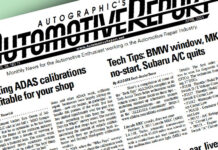By John Yoswick
For the past 15 years, Automotive Report has started the new year with a look back at some of the most important, interesting or entertaining quotes within the industry during the past 12 months. Here’s what was being said around the industry during 2015.
• • •
“I had to buy another tool box because of all the rivet guns I’ve collected. You start collecting those at $10,000 to $13,000 apiece, and it becomes a hobby I’m just not all that interested in.”
– Oregon shop owner Ron Reichen, speaking of the various equipment requirements for obtaining multiple OEM shop certifications
• • •
“This is not a finger-pointing exercise. It’s an exercise to see if we can do better due diligence in terms of what we’re equipping our employees with. Do all spraysuits perform the same? No. We have a full gamut here. Our objectives here were to determine if there is a viable way to test a suit for isocyanate exposure, and if so, do we see any variability when comparing suits. We absolutely can test the spraysuits, and absolutely can look at the variability within these suits and the type of protections they actually provide the painters. There are a lot of options out there, and unfortunately, shops are liable for choosing the correct suit, not the manufacturers and not the jobbers or distributors.”
– Brandon Thomas of GMG Envirosafe, reporting the results of testing his company did that found significant differences in the permeability of painter spraysuits
• • •
“It is not illegal for a party to decide it is unwilling to pay a higher hourly rate than its competitors have to pay, and the fact that a number of the [insurers] made statements to that effect does not tip the scales toward illegality.”
– U.S. District Court Judge Gregory Presnell discussing shops’ argument in a lawsuit that part of how insurers conspire to manipulate shop labor rates and compensation is by refusing to pay a higher labor rate than another; Presnell dismissed the lawsuit (brought by 20 Florida shops) for a second time in January of 2015, but allowed the shops to file an amended complaint, though he later dismissed that version of the lawsuit as well this past fall
• • •
“Nor have the [shops] explained how the conduct of one [insurer] in steering a customer away from one [shop] is related in any way to the conduct of a different [insurer] in steering a different customer away from the same or a different [shop].”
– Magistrate Judge Thomas Smith, in recommending in June the dismissal of 14 other similar lawsuits in which shops alleging that the insurers conspire to manipulate shop labor rates and compensation
• • •
“State Farm has violated Louisiana laws by engaging in a pattern of unfair and fraudulent business practices aimed at controlling the auto repair industry and forcing unsafe repairs on vehicles without the knowledge or consent of Louisiana consumers.”
– Louisiana Attorney General James “Buddy” Caldwell last August, after successfully having his state’s lawsuit against State Farm returned to state court from a U.S. District Court in Florida where it had previously been transferred
• • •
“They use their economic power to grind down working people.”
– Mississippi Attorney General Jim Hood, telling CNN last February he might follow Louisiana’s lead and file suit against one or more insurers; he has yet to do so, however
• • •
“Contrary to what consumers may be led to believe by their insurers, repair shops preferred by insurers do not necessarily equate with quality repairs. It seems to be common knowledge among auto repair shops that the best way to land a coveted spot on an insurer’s preferred list is not necessarily by delivering consistent, quality service, but by agreeing to charge below-market labor rates and to use cheaper, salvaged, used or even counterfeit parts of questionable quality and safety.”
– U.S. Senator Richard Blumenthal (D-CT), in announcing back in February that he was urging the Department of Justice to investigate whether insurers are directing consumers to shops that have agreed “to use cheaper and possibly more dangerous parts”
• • •
“It’s taken 14 years since we filed the case to get to the final decision on this thing. Even if they do have to pay that amount, can you imagine what they made by not having to change the way they do business for the 14 years?”
– Tony Ferraiolo, president of the Auto Body Association of Connecticut (ABAC), when asked in March if the $34.7 million dollar judgment against The Hartford in a class action lawsuit brought by the association and several shops would be enough to change the insurer’s behavior
• • •
“It would be patently unreasonable…for us to conclude that the [insurer] is lawfully permitted to determine the hourly labor rate that it is willing to pay for autobody repair [but] that [its] appraisers are ethically required to disregard that determination when negotiating on the [insurer’s] behalf.”
– from the Connecticut Supreme Court ruling in July overturning the $34.7 million dollar judgment against The Hartford
• • •
“The training and consulting work I do has shown me that many shops aren’t aware of non-included items and operations they are doing but not itemizing on estimates. These surveys will help shops understand what these operations are, and whether other shops seek and receive compensation for them — or if they truly are ‘the only one.’”
– Mike Anderson of Collision Advice, in announcing last spring the first of his quarterly “Who Pays For What” surveys (www.CollisionAdvice.com/survey)
• • •
“Unless something dramatic happens, Farmers will drop yet another spot to seventh in 2015.”
– From Auto Insurance Report, in noting that USAA surpassed Farmers Insurance in terms of personal auto insurance market share (just as Progressive and Geico did in 2004 and 2007, respectively) and that Liberty Mutual is close to doing the same
• • •
“Apparently we’re filling a need. There’s demand for this information and we’re happy to see that.”
– I-CAR CEO John Van Alstyne, noting that his organization’s new “Repairability Technical Support Portal” (https://rts.i-car.com/) had received more than 900 “Ask I-CAR” inquiries in its first six months; the site allows users to search the responses to inquiries as to the availability of sectioning or other OEM repair procedures, or call or email in their own inquiry if the question has not previously been answered
• • •
“But now our federal staff is very much focused on this. They’re out meeting with legislators. We’re trying to get this a hearing by Memorial Day, and sign up additional [Congressional] sponsors. We’re hopeful our efforts will help push things over the top and get some real concrete progress on the PARTS Act in 2015.”
– Bob Passmore of the Property-Casualty Insurance Association of America, speaking in April about proposed federal legislation that that would slash automaker’s design patents on parts from 14 years to just 30 months (thus allowing earlier introduction of non-OEM versions of the parts); no hearing has been held on the bill
• • •
“When I started 26 years ago, almost 100 percent of our funding was from the insurers. Today we’re down to about 11 percent. We now have the ability as a much more independent organization to work solely in the best interests of consumers and the industry. And that’s our goal.”
– Jack Gillis, executive director of the Certified Automotive Parts Association (CAPA), seemingly acknowledging last spring that CAPA’s historic dependence on financing from insurers has meant it couldn’t work solely in the best interest of consumers
• • •
“So if a customer says they want a particular part on their vehicle — ‘I want OE parts’ — we allow that. We absolutely accommodate the customer’s request associated with that. We do. We always will.”
– Allstate’s Randy Hanson saying that his company believes in customer choice in terms of parts
• • •
“Well, if that is Allstate’s policy, they are doing a pretty good job keeping it a secret from me.”
– An Arizona shop owner, having been told of Hanson’s statement
• • •
“We believe that certification allows us to tell a very powerful story in terms of the consumer. We only use CAPA-certified crash parts on our estimates.”
– Allstate’s Hanson
• • •
“I believe the adjusters write the lowest-priced part available. They will allow us to change the estimate to the appropriate part, but that’s not what is always on the initial estimate.”
– The owner of an upper-Midwest shop that participates in the Allstate direct repair program, having been told of Hanson’s statement
• • •
“Just imagine that front-radar system being off two or three degrees at the vehicle. By the time it gets out 400 or 600 feet ahead of the vehicle, it could be looking at vehicles in the other lane. So it could conceivably be putting on the brakes or telling the driver there’s a problem when there isn’t anything.”
– Ben Cid of Mercedes-Benz on the importance of having vehicle cameras and sensors aligned properly after collision repairs
• • •
“You don’t pay extra for your seatbelt, and you shouldn’t have to pay extra for technology that can help prevent a collision altogether.”
– Christopher Hart, chairman of the National Transportation Safety Board (NTSB), in recommending that collision avoidance systems become standard equipment on all new passenger vehicles
• • •
“We’re putting the brakes on rear-end crashes.”
– National Highway Traffic Safety Administration (NHTSA) Administrator Mark Rosekind, announcing this past fall that beginning with model year 2018, the agency’s 5-star rating system will include automatic emergency braking as a recommended safety technology
• • •
“What ‘Class B’ shops get paid has a lot to do with how they respond to the survey, just as how ‘Class A’ shops get paid has a lot to do with how they respond. This law allows shops and insurers to see what the real market is when you narrow it down on both levels. Right now we’re all lumped together, and we’re not all made the same.”
– Jina Petrarca-Karampetsos of the Auto Body Association of Rhode Island on the new law (going into effect this month) in that state that creates two tiers of body shops (‘Class A’ shops must have at least one automaker certification for aluminum repair, for example) and requires insurers to segment out their labor rate survey data to determine “separate and distinct” prevailing labor rates for the two classes of shops
• • •
“That’s more of a ‘we’ problem than a ‘you’ problem. We certainly cause those issues, the old ‘in on Monday, out on Friday,’ rather than just getting things level. That’s definitely something that could be worked on.”
– Chris Andreoli of Progressive Insurance, acknowledging at a shop gathering that the insurer contributes to inefficient scheduling of work in shops
• • •
“How many Ford F-150s hit in the left front with a certain velocity do we need to fix before we can get to a decent confidence level to predict that loss cost up front, and allow you guys to do what you do best: fix the car. There are advantages to both [shops and repairers]. It’s not going to be for every car. But we think the industry is primed to move in that direction.”
– Clint Marlow, one of two national auto claims directors at Allstate, indicating that information about an accident gleaned from a vehicle’s own systems, coupled with historic claims data, could potentially reduce the need for the traditional estimating process
• • •
“I think there’s a pervasive belief [among insurers] that market practice should influence repair procedure. The argument can be: ‘Well, that’s not market practice to charge for that,’ even if it is a documented OEM procedure. I think one of the best things that any insurer could do would be to stop arguing [about] documented OEM required procedures, and simply focus on discussing areas that are more subjective. That would make the process go a lot better and also would encourage much better quality repairs. The consumer would ultimately win.”
– Aaron Schulenburg, executive director of the Society of Collision Repair Specialists
• • •
“The claims department comes to the repair community with a procurement mentality, where they say, ‘We need to have a discount on these repairs in some manner or form.’ They’re trying to control costs, and understandably so. However, the auto manufacturers went through that process for so many years, where they dictated terms to their suppliers. And it worked for a while. But eventually [the automakers] realized they needed to build collaborative efforts with their suppliers. Telling a provider that you’re going to pay them less doesn’t reduce their costs. So I would tell an insurer: If you want to have a lower price, help us reduce our costs, then we can both share in that cost-savings.”
– California shop owner and Collision Industry Conference chairman Randy Stabler •
John Yoswick, a freelance writer based in Portland, Ore., who has been writing about the automotive industry since 1988, is also the editor of the weekly CRASH Network (for a free 4-week trial subscription, visit www.CrashNetwork.com). He can be contacted by email at jyoswick@SpiritOne.com.



